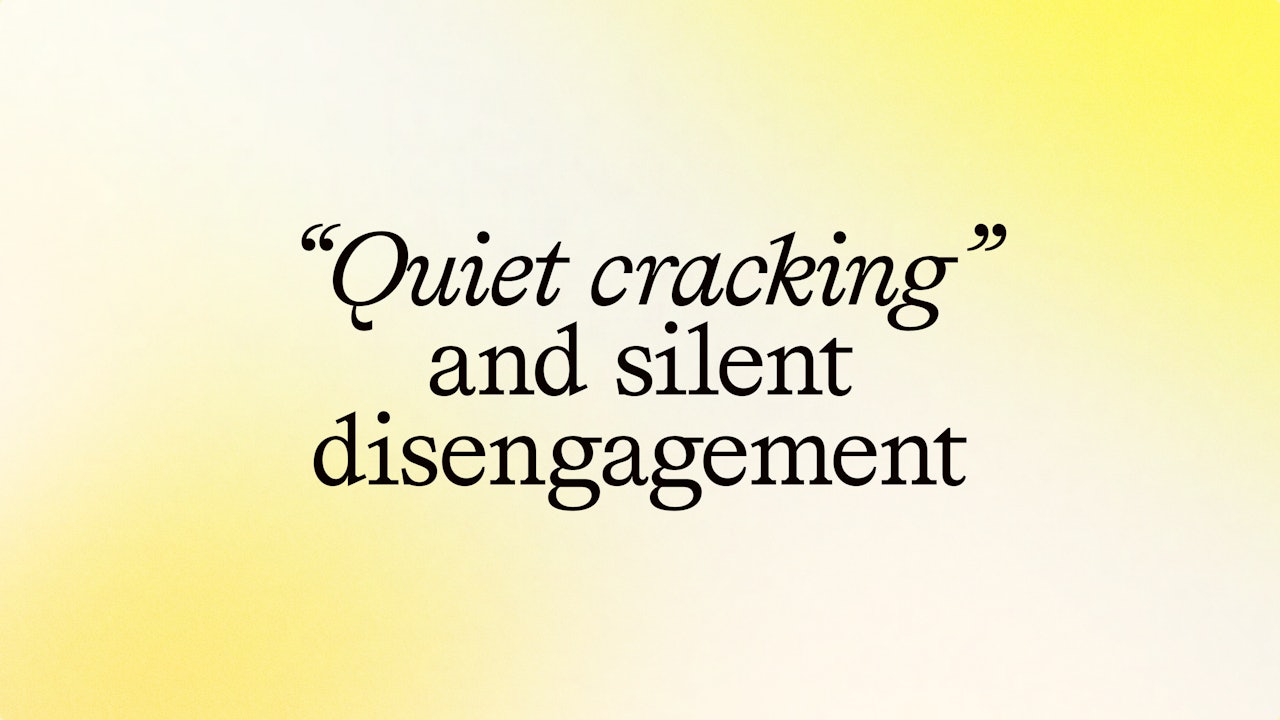“Quiet cracking” and silent disengagement

Raya Moshiri
20 October 2025

Content
- Quiet Cracking: The Hidden Strain Leaders Can’t Afford to Ignore
- What quiet cracking looks like (and why you might be missing it)
- Why quiet cracking is on the rise
- How to spot it before it’s too late
- Why it matters more than you think
- What leaders can do about It
- The leadership imperative
Quiet Cracking: The Hidden Strain Leaders Can’t Afford to Ignore
Most leaders have seen burnout. Many have talked about “quiet quitting.”
But there’s a new workplace reality unfolding, one that’s harder to spot, harder to measure, and far more damaging over time.
It’s called quiet cracking, and if you lead people, chances are it’s already happening on your team.
Quiet cracking is what happens when employees keep showing up, keep performing, and keep smiling in meetings, while quietly coming undone inside. They’re not disengaged enough to quit, but they’re no longer thriving. And by the time you notice, the damage to their wellbeing, your culture, and your bottom line is already underway.
What quiet cracking looks like (and why you might be missing it)
Quiet cracking isn’t dramatic. It’s not an outburst or a resignation email. It’s the subtle erosion of someone’s emotional connection to their work.
They’re still here – still hitting targets, still replying to emails – but the spark is gone. Conversations become more transactional. Creativity dries up. Initiative slips away.
And because they’re still functioning, most leaders don’t realize anything’s wrong.
“I used to love problem-solving with my team,” one employee told Business Insider. “Now I just get through the day. By the time I get home, I’m exhausted from pretending everything’s fine.” (Business Insider, 2025)
Why quiet cracking is on the rise
The conditions for quiet cracking are everywhere, and many of them are byproducts of the modern workplace itself.
- Economic uncertainty keeps people stuck. Even if they’re unhappy, many employees feel they can’t risk a job change right now. They stay and fracture quietly. (Business Insider, 2025)
- Role ambiguity wears people down. Constant restructuring, shifting priorities, and unclear expectations erode motivation over time. (John Addison Leadership)
- Recognition is missing. Effort that goes unnoticed sends a powerful message: “What I do doesn’t matter.” (WorkNest)
- Fear shuts down honesty. In cultures where speaking up feels risky, employees internalize stress and over time, that internal pressure becomes cracks. (SHRM)
It’s a perfect storm: people feel trapped, undervalued, and unable to speak up – so they keep going while slowly disconnecting.
How to spot it before it’s too late
By the time someone stops showing up, it’s already too late. The key is noticing early, subtle shifts. Leaders should keep an eye out for:
- Reduced collaboration: People speak up less in meetings or avoid team discussions.
- Loss of initiative: They stop volunteering for new projects.
- Emotional flatness: Wins don’t excite them anymore.
- Change resistance: New tools or ideas are met with hesitation, not curiosity.
- Withdrawal: They’re more absent – physically or mentally than they used to be.
Alone, these signals might seem small. Together, they could be telling you something deeper: your people are cracking under the surface.
Why it matters more than you think
Quiet cracking isn’t just a “people problem.” It’s a performance problem and a costly one.
- Innovation drops. People who feel emotionally drained stop bringing new ideas.
- Retention risk skyrockets. By the time they walk out the door, you’ve already lost them.
- Culture deteriorates. Disengagement spreads quickly, and silently.
- Wellbeing suffers. Quiet cracking often leads to anxiety, depression, and burnout if left unchecked.
As Namely put it, “Quiet cracking doesn’t break a business overnight – it weakens it from the inside out.” (Namely)
What leaders can do about It
The good news: you can prevent quiet cracking – but only if you’re proactive. Here’s how to start.
1. Make check-ins count
Skip the “How’s everything going?” autopilot. Ask specific questions about energy, workload, and motivation. And when people share concerns, follow up with action.
2. Build psychological safety
When people feel safe admitting they’re struggling, cracks are far less likely to form. Model vulnerability from the top and reward honesty, not just resilience.
3. Recognize effort not just outcomes
A thank-you, a shout-out in a meeting, or a note from a senior leader can be a powerful buffer against disengagement.
4. Clarify the “why” behind the work
People need to understand how their efforts connect to a bigger purpose. Clarity isn’t just good for performance – it’s essential for mental wellbeing.
5. Create real, proactive support, not just crisis care
Here’s where many organizations fall short. Support often only arrives when someone is already at breaking point – after a sick note, a resignation, or a performance drop. But by then, the damage is done.
What people need most is preventative care: everyday tools to manage stress before it spirals, easy access to confidential help, and a culture that encourages small, consistent steps to protect mental health. Solutions that meet people where they are – from self-guided resources to coaching and therapy – don’t just improve wellbeing. They reduce risk, improve retention, and strengthen culture from the ground up.
The leadership imperative
Quiet cracking is a warning sign – not of failure, but of opportunity. It’s a signal that your people are carrying more than they’re saying. And as a leader, you have the power to change that.
Start by listening, really listening. Make space for honest conversations. Recognize effort, celebrate progress, and give people clarity and purpose. And above all, make support visible and accessible before people hit a wall.
Because when we stop expecting people to “hold it together” in silence and start building workplaces that help them stay well, everyone benefits. Your people thrive. Your teams perform. And your business becomes more resilient than ever.
Supporting mental health shouldn’t start when cracks appear – it should prevent them from forming. See how Unmind can help you do just that.
About the Author

Raya Moshiri, Marketing Associate
I’m Raya Moshiri, and I help organizations bring proactive mental health support to life by coordinating programs, resources, and experiences that drive engagement and real-world impact. Based in New York, I’m dedicated to making workplace wellbeing both attainable and actionable.
About the Author

Raya Moshiri, Marketing Associate
I’m Raya Moshiri, and I help organizations bring proactive mental health support to life by coordinating programs, resources, and experiences that drive engagement and real-world impact. Based in New York, I’m dedicated to making workplace wellbeing both attainable and actionable.